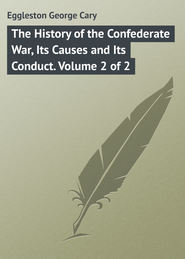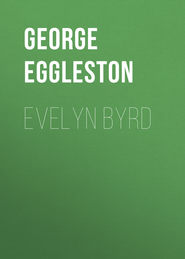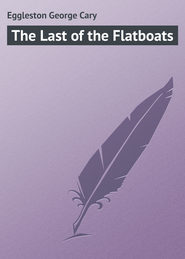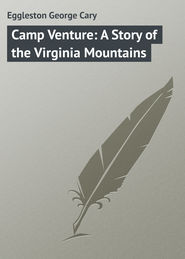По всем вопросам обращайтесь на: info@litportal.ru
(©) 2003-2024.
✖
What Happened at Quasi: The Story of a Carolina Cruise
Настройки чтения
Размер шрифта
Высота строк
Поля
A PROGRAMME – SUBJECT TO CIRCUMSTANCES
The Hunkydory was an unusually large boat for a craft of that kind. She was about twenty-five feet long, very wide amidships – as dories always are – and capable of carrying a heavy load without much increase in her draught of water. She was built of white cedar with a stout oak frame, fastened with copper bolts and rivets, and fitted with capacious, water-tight lockers at bow and stern, with narrower lockers running along her sides at the bilge, for use in carrying tools and the like.
She carried a broad mainsail and a large jib, and had rowlocks for four pairs of oars. Sitting on the forward or after rowing thwart, where she was narrow enough for sculls, one person could row her at a fair rate of speed, so little resistance did her peculiar shape offer to the water. With two pairs of oars, or better still, with all the rowlocks in use, she seemed to offer no resistance at all.
It was the plan of the boys to depend upon the sails whenever there was wind enough to make any progress at all, and ply the oars only when a calm compelled them to do so.
“We’re in no sort of hurry,” explained Larry, “and it really makes no difference whether we run one mile an hour or ten. There aren’t any trains to catch down where we are going.”
“Just where are we going, Larry,” asked Dick. “We’ve never talked that over, except in the vaguest way.”
“Show the boys, Cal,” said Larry, turning to his brother. “You’re better at coast geography than I am.”
“Hydrography would be the more accurate word in this case,” slowly answered Cal, “but it makes no difference.”
With that he lighted three or four more gas burners, and spread a large map of the coast upon the table.
“Now let me invoke your earnest attention, young gentlemen,” he began. “That’s the way the lecturers always introduce their talks, isn’t it? You see before you a somewhat detailed map of the coast and its waterways from Charleston, south to Brunswick, Georgia. It is grossly inaccurate in some particulars and slightly but annoyingly so in others! Fortunately your lecturer is possessed of a large and entirely trustworthy fund of information, the garnerings, as it were, of prolonged and repeated personal observation. He will be able to correct the errors of the cartographer as he proceeds.
“We will take the Rutledge boathouse on the Ashley River near the foot of Spring Street as our point of departure, if you please. Enteuthen exelauni– pardon the lapse into Xenophontic Greek – I mean thence we shall sail across the Ashley to the mouth of Wappoo Creek which, as you see by the map, extends from Charleston Harbor to Stono Inlet or river, separating James Island from the main. Thence we shall proceed up Stono River, past John’s Island, and having thus disposed of James and John – familiar characters in that well-remembered work of fiction, the First Reader – we shall enter the so called North Edisto River, which is, in fact, an inlet or estuary, and sail up until we reach the point where the real Edisto River empties itself. Thence we shall proceed down the inlet known as South Edisto River round Edisto Island, and, by a little detour into the outside sea, pass into St. Helena Sound. From that point on we shall have a tangled network of big and little waterways to choose among, and we’ll run up and down as many of them as tempt us with the promise of sport or adventure. We shall pass our nights ashore, and most of our days also, for that matter. Wherever we camp we will remain as long as we like. That is the programme. Like the prices in a grocer’s catalogue and the schedules of a railway, it is ‘subject to change without notice.’ That is to say, accident and unforeseen circumstances may interfere with it at any time.”
“Yes, and we may ourselves change it,” said Larry. “Indeed, I propose one change in it to start with.”
“What is it?” asked the others in chorus.
“Simply that we sail down the harbor first to give Dick and Tom a glimpse of the points of interest there. We’ll load the boat first and then, when we’ve made the circuit of the bay, we needn’t come back to the boat house, but can go on down Wappoo cut.”
The plan commended itself and was adopted, and as soon as the Hunkydory’s seams were sufficiently soaked the boat was put in readiness. There was not much cargo to be carried, as the boys intended to depend mainly upon their guns and fishing tackle for food supplies. A side of bacon, a water-tight firkin of rice, a box of salt, another of coffee, a tin coffee-pot, and a few other cooking utensils were about all. The tools and lanterns were snuggled into the places prepared for them, an abundance of rope was bestowed, and the guns, ammunition and fishing tackle completed the outfit. Each member of the little company carried a large, well-stocked, damp-proof box of matches in his pocket, and each had a large clasp knife. There were no forks or plates, but the boat herself was well supplied with agate iron drinking cups.
It was well after dark when the loading was finished and the boat in readiness to begin her voyage. It was planned to set sail at sunrise, and so the crew went early to the joggling boards for a night’s rest in the breezy veranda.
“We’ll start if there’s a wind,” said Cal.
“We’ll start anyhow, wind or no wind,” answered Larry.
“Of course we will,” said Cal. “But you used the term ‘set sail.’ I object to it as an attempt to describe or characterize the process of making a start with the oars.”
“Be quiet, Cal, will you?” interjected Dick. “I was just falling into a doze when you punched me in the ribs with that criticism.”
IV
TOM FIGHTS IT OUT
Fortunately there was a breeze, rather light but sufficient, when the sun rose next morning. The Hunkydory was cast off and, with Cal at the tiller, her sails filled, she heeled over and “slid on her side,” as Tom described it, out of the Ashley River and on down the harbor where the wind was so much fresher that all the ship’s company had to brace themselves up against the windward gunwale, making live ballast of themselves.
The course was a frequently changing one, because the Rutledge boys wanted their guests to pass near all the points of interest, and also because they wanted Dick Wentworth, who was the most expert sailor in the company, to study the boat’s sailing peculiarities. To that end Dick went to the helm as soon as the wind freshened, and while following in a general way the sight-seeing course suggested by the Rutledges, he made many brief departures from it in order to test this or that peculiarity of the boat, for, as Larry explained to Tom, “Every sailing craft has ways of her own, and you want to know what they are.”
After an hour of experiment, Dick said:
“We’ll have to get some sand bags somewhere. We need more ballast, especially around the mast. As she is, she shakes her head too much and is inclined to slew off to leeward.”
“Let me take the tiller, then, and we’ll get what we need,” answered Larry, going to the helm.
“Where?”
“At Fort Sumter. I know the officer in command there – in fact, he’s an intimate friend of our family, – and he’ll provide us with what we need. How much do you think?”
“About three hundred pounds – in fifty pound bags for distribution. Two hundred might do, but three hundred won’t be too much, I think, and if it is we can empty out the surplus.”
“How on earth can you tell a thing like that by mere guess work, Dick?” queried Tom in astonishment.
“It isn’t mere guess work,” said Dick. “In fact, it isn’t guess work at all.”
“What is it, then?”
“Experience and observation. You see, I’ve sailed many dories, Tom, and I’ve studied the behavior of boats under mighty good sea schoolmasters – the Gloucester fishermen – and so with a little feeling of a boat in a wind I can judge pretty accurately what she needs in the way of ballast, just as anybody who has sailed a boat much, can judge how much wind to take and how much to spill.”
“I’d like to learn something about sailing if I could,” said Tom.
“You can and you shall,” broke in Cal. “Dick will teach you on this trip, and Larry and I will act as his subordinate instructors, so that before we get back from our wanderings you shall know how to handle a boat as well as we do; that is to say, if you don’t manage to send us all to Davy Jones during your apprenticeship. There’s a chance of that, but we’ll take the risk.”
“Yes, and there’s no better time to begin than right now,” said Dick. “That’s a ticklish landing Larry is about to make at Fort Sumter. Watch it closely and see just how he does it. Making a landing is the most difficult and dangerous thing one has to do in sailing.”
“Yes,” said Cal; “it’s like leaving off when you find you’re talking too much. It’s hard to do.”
The little company tarried at the fort only long enough for the soldiers to make and fill six canvas sand bags. When they were afloat again and Dick had tested the bestowal of the ballast, he suggested that Tom should take his first lesson at the tiller. Sitting close beside him, the more expert youth directed him minutely until, after perhaps an hour of instruction, during which Dick so chose his courses as to give the novice both windward work and running to do, Tom could really make a fair showing in handling the sails and the rudder. He was still a trifle clumsy at the work and often somewhat unready and uncertain in his movements, but Dick pronounced him an apt scholar, and predicted his quick success in learning the art.
They were nearing the mouth of the harbor when Dick deemed it best to suspend the lesson and handle the boat himself. The wind had freshened still further, and a lumpy sea was coming in over the bar, so that while there was no danger to a boat properly handled, a little clumsiness might easily work mischief.
The boys were delighted with the behavior of the craft and were gleefully commenting on it when Larry observed that Tom, instead of bracing himself against the gunwale, was sitting limply on the bottom, with a face as white as the newly made sail.
“I say, boys, Tom’s seasick,” he called out. “We’d better put about and run in under the lee of Morris Island.”
“No, don’t,” answered Tom, feebly. “I’m not going to be a spoil-sport, and I’ll fight this thing out. If I could only throw up my boots, I’d be all right. I’m sure it’s my boots that sit so heavily on my stomach.”
“Good for you, Tom,” said Larry, “but we’ll run into stiller waters anyhow. We don’t want you to suffer. If you were rid of this, I’d – ”
He hesitated, and didn’t finish his sentence.
“What is it you’d do if I weren’t playing the baby this way?”
“Oh, it’s all right.”
“No, it isn’t,” protested Tom, feeling his seasickness less because of his determination to contest the point. “What is it you’d do? You shall do it anyhow. If you don’t, I’ll jump overboard. I tell you I’m no spoil-sport and I’m no whining baby to be coddled either. Tell me what you had in mind.”
“Oh, it was only a sudden thought, and probably a foolish one. I was seized with an insane desire to give the Hunkydory a fair chance to show what stuff she’s made of by running outside down the coast to the mouth of Stono Inlet, instead of going back and making our way through Wappoo creek.”
“Do it! Do it!” cried Tom, dragging himself up to his former posture. “If you don’t do it I’ll quit the expedition and go home to be put into pinafores again.”











